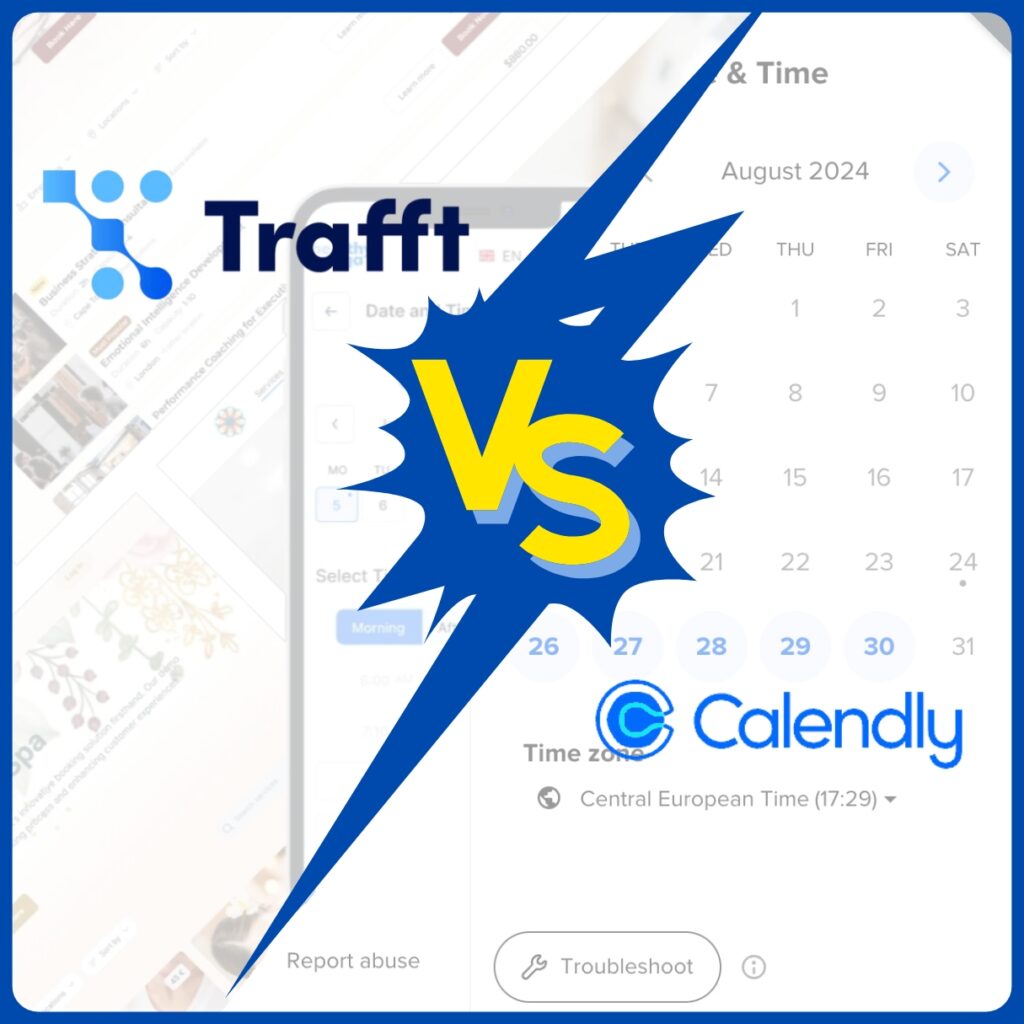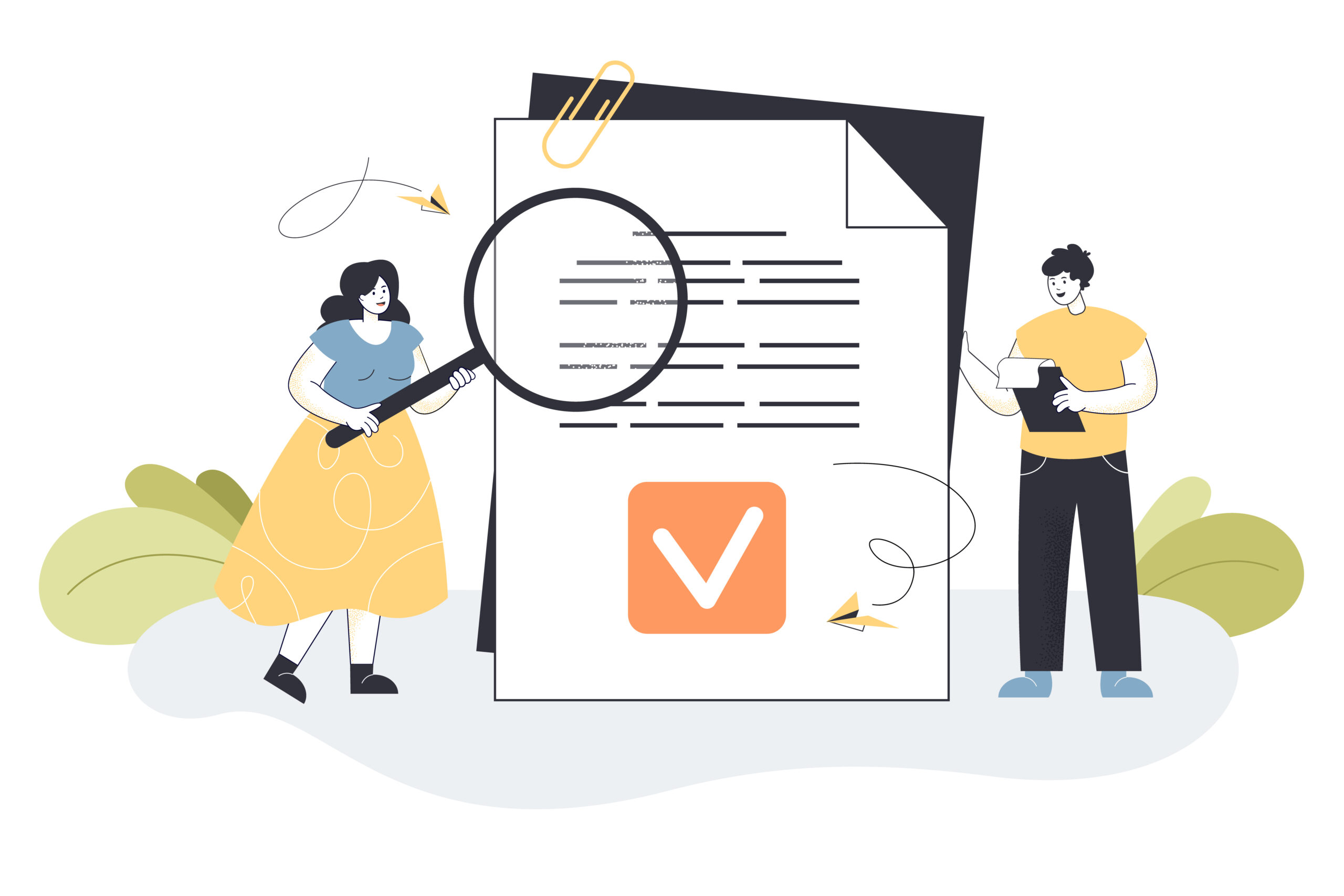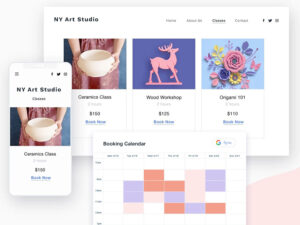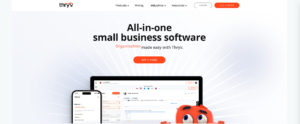In a world where time is more valuable than ever, efficient scheduling can make all the difference in staying organized and productive. This goes for both your personal and professional obligations. However, with a substantial number of scheduling tools available, choosing the right one can take a lot of time and effort.
To help in your endeavor, we chose two prominent names in the industry - Trafft and Calendly - which both offer distinctive features and benefits. However, there are some differences and limitations that you should be aware of.
In this article, we’ll dive into a detailed comparison of Trafft vs. Calendly, exploring their key features, integrations, pricing, support, and more. So, by the end, you’ll better understand which tool better aligns with your needs.
Trafft vs. Calendly: Overview
To briefly summarize both tools, here is what they offer:
Calendly- This widely popular scheduling tool is known for its user-friendly interface. It offers seamless integration with various calendar platforms. It’s designed to help individuals and smaller teams streamline meeting scheduling. The goal is to reduce the back-and-forth communication needed to find a suitable meeting time.
Traff- While much newer, Trafft is a versatile appointment scheduling solution that caters to various industries. The emphasis is on the customizability of the booking solution and a robust set of features for managing appointments. This software is tailored to those who require a more advanced approach to scheduling.
While both tools provide valuable features, their suitability will depend on your specific needs. So, let’s get into specifics.
Features: What Can Each Tool Do?
Both software have impressive features and can do so much for your everyday scheduling needs. However, each tool has a slightly different array, which will likely be the deciding factor.
Trafft’s key features
- Client Management: Traffts offers a robust client management system to help you maintain and enhance customer interactions.
- Customizability: It provides many customization options for a booking page, so you can easily include your branding and choose an appropriate layout.
- Ease of use: Trafft is known for its straightforward and user-friendly interface despite the plethora of advanced features. It allows users to quickly set up a booking page and services offered.
- Marketing Tools Integrations: Trafft features integrations with some of the best email marketing tools, such as Mailchimp and SendFox. There are also integrations with WhatsApp and Acumbamail to help you engage with your customers while marketing your services.
- Calendar Integrations: You can easily connect Google Calendar, Microsoft Outlook, or Apple Calendar so all your appointments are in one place and automatically added once someone schedules.
- Payment Flexibility: Not only are there integrations with some of the most used payment platforms (PayPal, Stripe, Mollie, Authorize.Net), but there is also an option to pay for service fully online or make a deposit payment and settle the rest on-site. Additionally, there is a feature for refunding the payment to the client.
- Employee Management: You can set up custom roles for all your employees, put in their special days, or add their time zones. Even better, they can put in their shifts and adjust their availability so there are no scheduling conflicts.
- Client Loyalty: Fostering client loyalty can be done through various Trafft features. There is a coupon option for all your loyal clients, and you can set the terms for when and to whom they are sent. Besides, you can set up customized SMS and Email appointment reminders so your clients always show up.
- Recurring Appointments: Let your customers book appointments that repeat daily, weekly, or monthly, all in a single booking process.
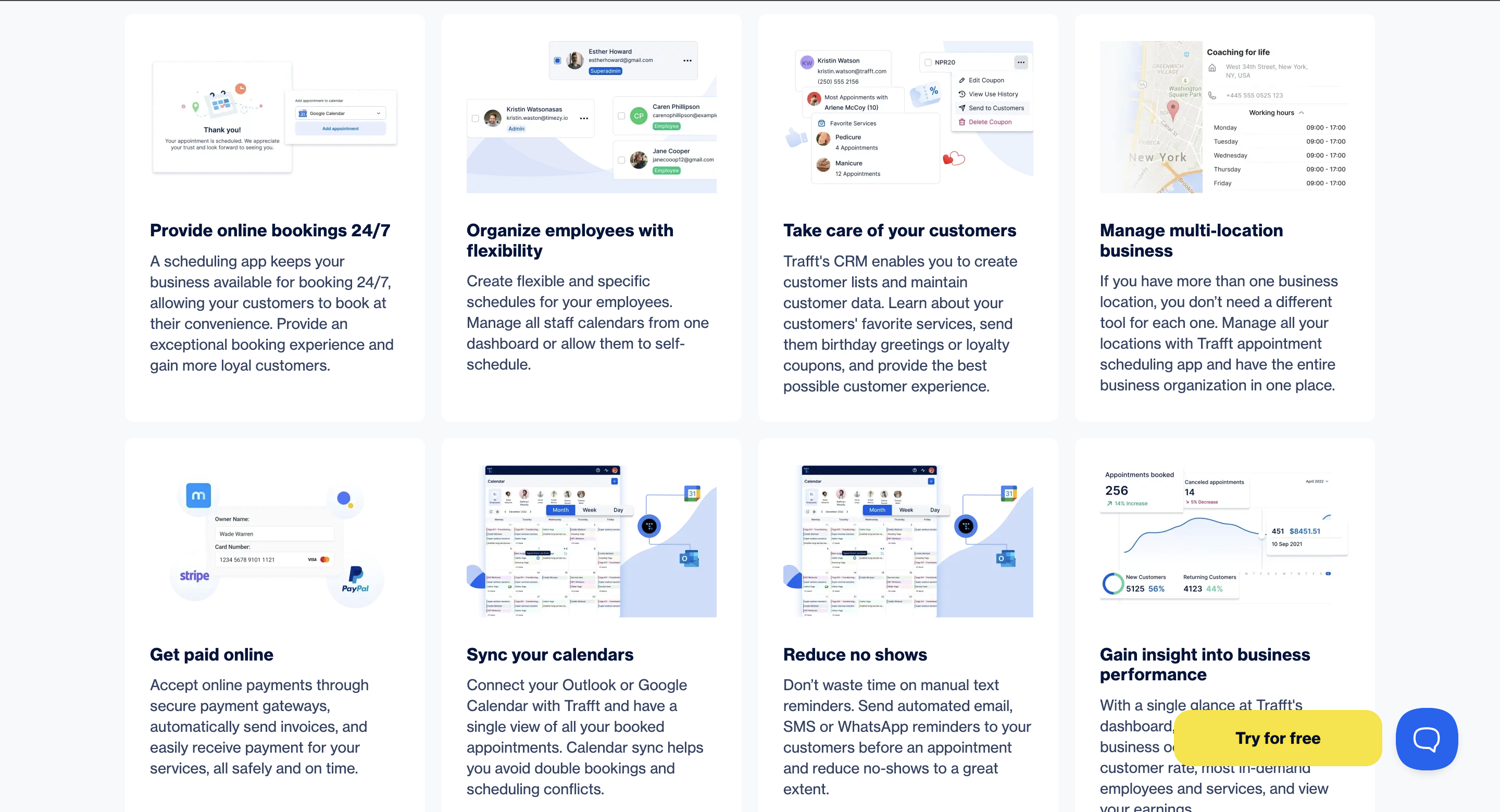
Calendly’s key features
- Availability Preferences: You can set up which days you are completely unavailable or set up just a few slots for specific days.
- Team Meeting Schedulings: Navigating each team member's availability can be simplified by offering a few meeting time slots and letting each member vote for the most suitable one.
- Calendar Integrations: A user can connect up to six calendars. To make things easier, Calendly offers integrations with Google Calendar, Outlook, and iCloud Calendar.
- CRM Data Base: All customer data can be automatically transferred to Salesforce, Hubspot, or Microsoft Dynamics 365. Your client information stays in one place and can be easily used later on.
- Premeeting Questions: Add specific questions your clients must answer before they book a meeting with you. Depending on the type of industry you are in, you can ask essential questions needed to help you better prepare for an appointment.
Trafft vs. Calendly: Feature-by-Feature Comparison
Easy to use
Trafft offers an intuitive interface designed to streamline the scheduling process. While it’s much more feature-rich, Trafft aims to balance complexity with user-friendliness. Its layout is organized in a way that guides users through the setup process. Trafft allows the user to manage their scheduling needs with minimal friction. You can easily configure appointment types, set up availability, and customize a booking page. Although Trafft includes advanced features, its design focuses on making these tools accessible and manageable without in-depth knowledge.
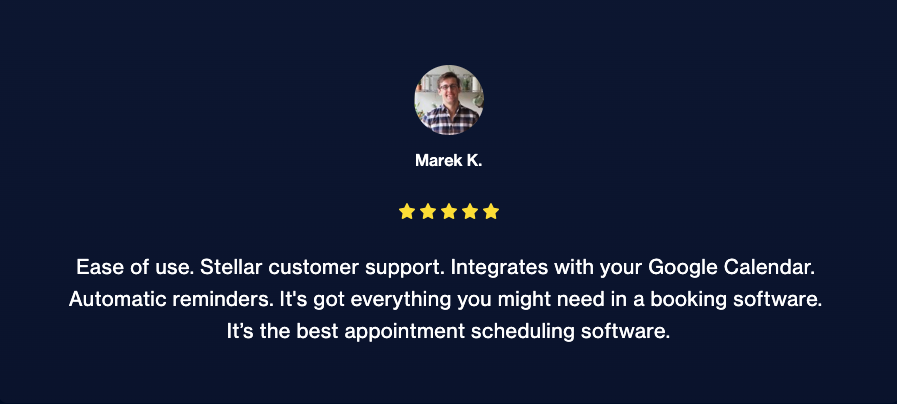
In comparison, Calendly is known for its user-friendly interface that allows users to set up scheduling options quickly. It has a clean design and an easy-to-navigate dashboard. This simplifies event creation and management. Users can easily set up their availability, sync their calendars, and specify meeting durations. However, with only a few customization options and a lack of more complex features, Calendly may not be suitable for the majority of service business owners.
Lastly, both Trafft and Calendly offer mobile apps for easy access to the dashboard for managing appointments.
Booking page
Both software lets you create your booking form with just a few clicks. The main difference here is that with Trafft, you can choose the light or dark theme, add your pictures, branding, and everything else needed to make your page stand out.
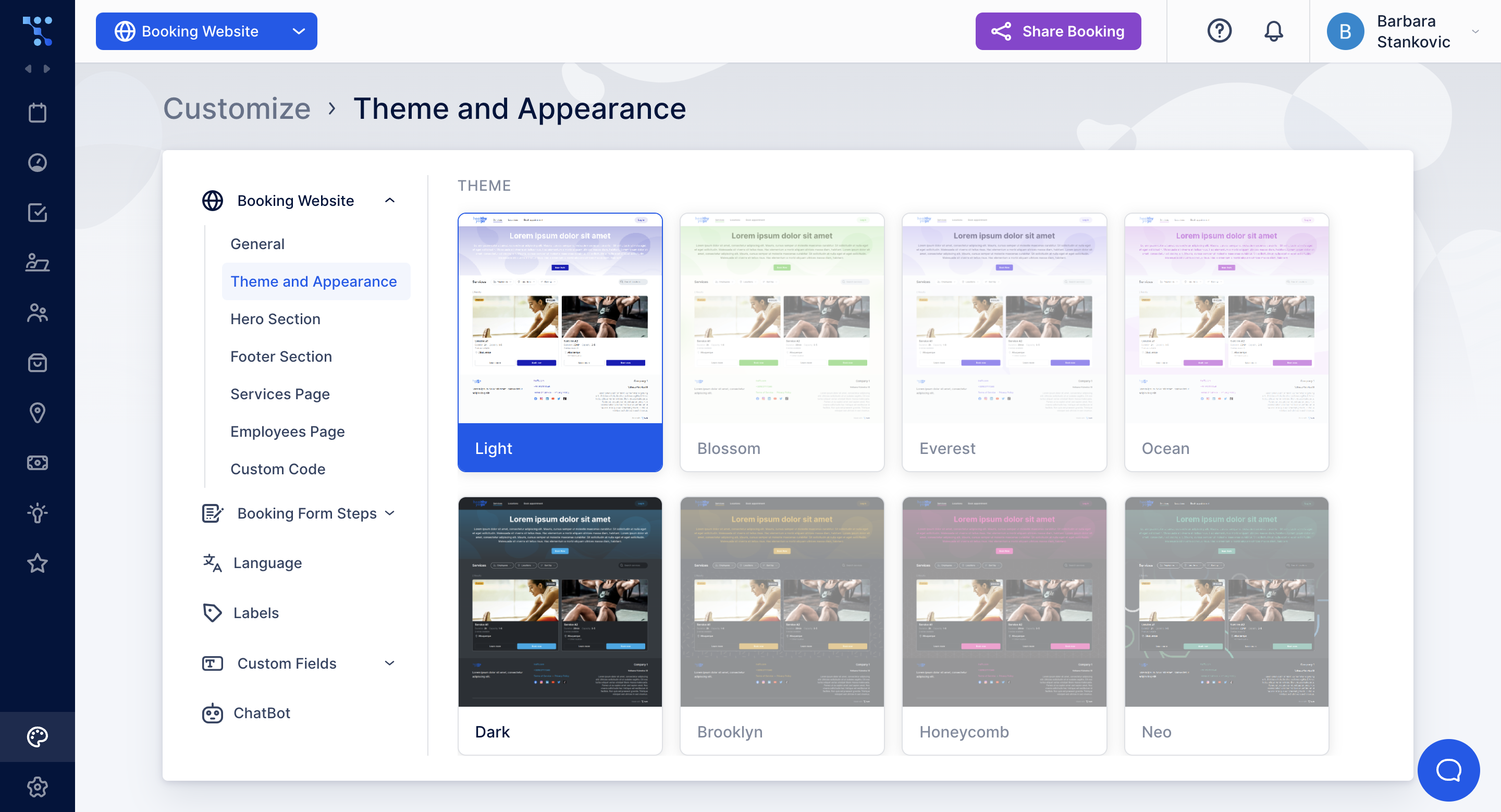
With Calendly, you can organize your events in different categories and change the color of each of them so they are easily distinguishable. This tool is as straightforward as it can be, so you cannot do much to make it fit your brand more.
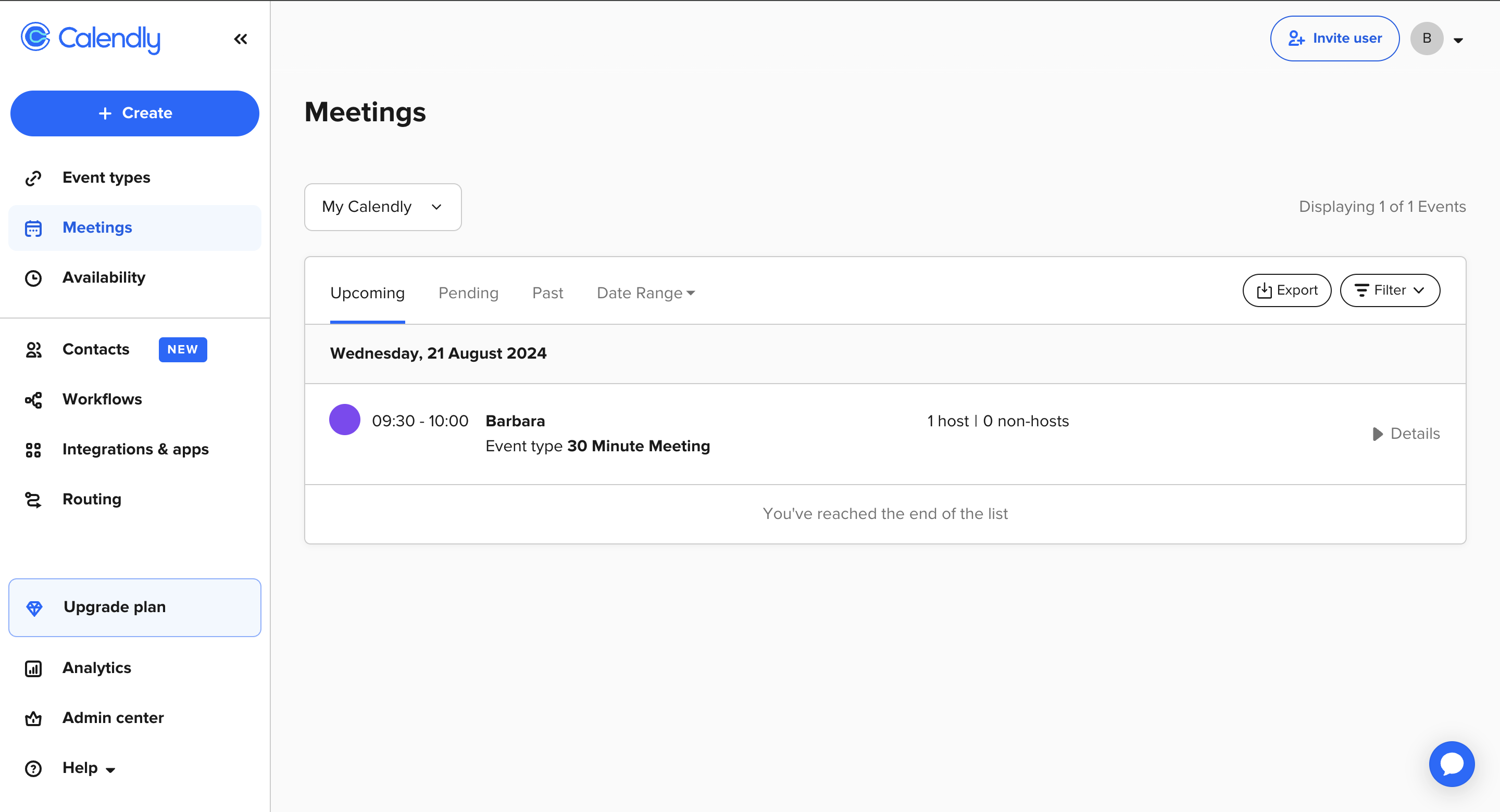
Regardless of your choice, both offer an embedable booking form so you can place it on your website if that’s what you prefer.
Either way, for many users, branding customization is the deciding factor, and in this regard, Trafft truly shines. If you are one of them, we think that settles this Trafft vs. Calendly debate.
Scheduling options
When we look at the scheduling options, both platforms offer a variety of features to accommodate different types of appointments.
Trafft lets users fully personalize appointment types and offer as many different ones as they want. Create custom services with unique names, descriptions, durations, and prices. You can also set your own availability, including working hours, break times, and days off.
With Trafft, you can offer individual appointments, group bookings, and recurring appointments. And if your business has more than one location where you offer services, you can enable multiple locations feature. It’s important to mention that recurring appointments are a feature that lets you schedule sessions that repeat daily, weekly, or monthly, all in a single booking process. It significantly enhances convenience for a customer and a business, too. However, this feature cannot be found on Calendly.
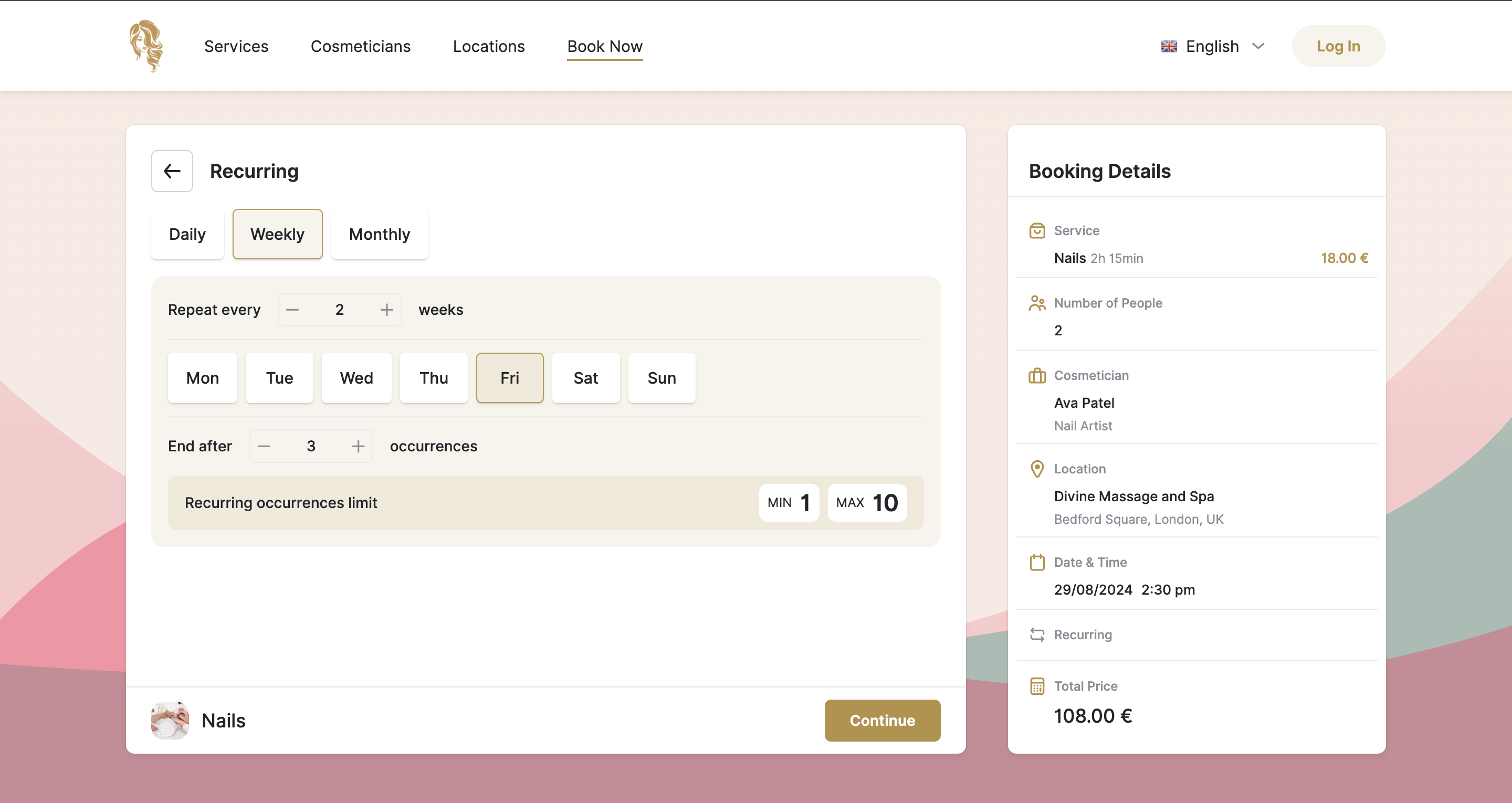
But when we look at what Calendly can do, it also offers one-on-one scheduling options and group events with one or more hosts. Another feature that it offers is round-robin scheduling, which can be great for sales teams. Similar to Trafft, it also has automatic time-zone detection, and you can set up your own availability. However, it’s obvious that it’s more geared towards businesses relying on meeting scheduling than on appointment booking.
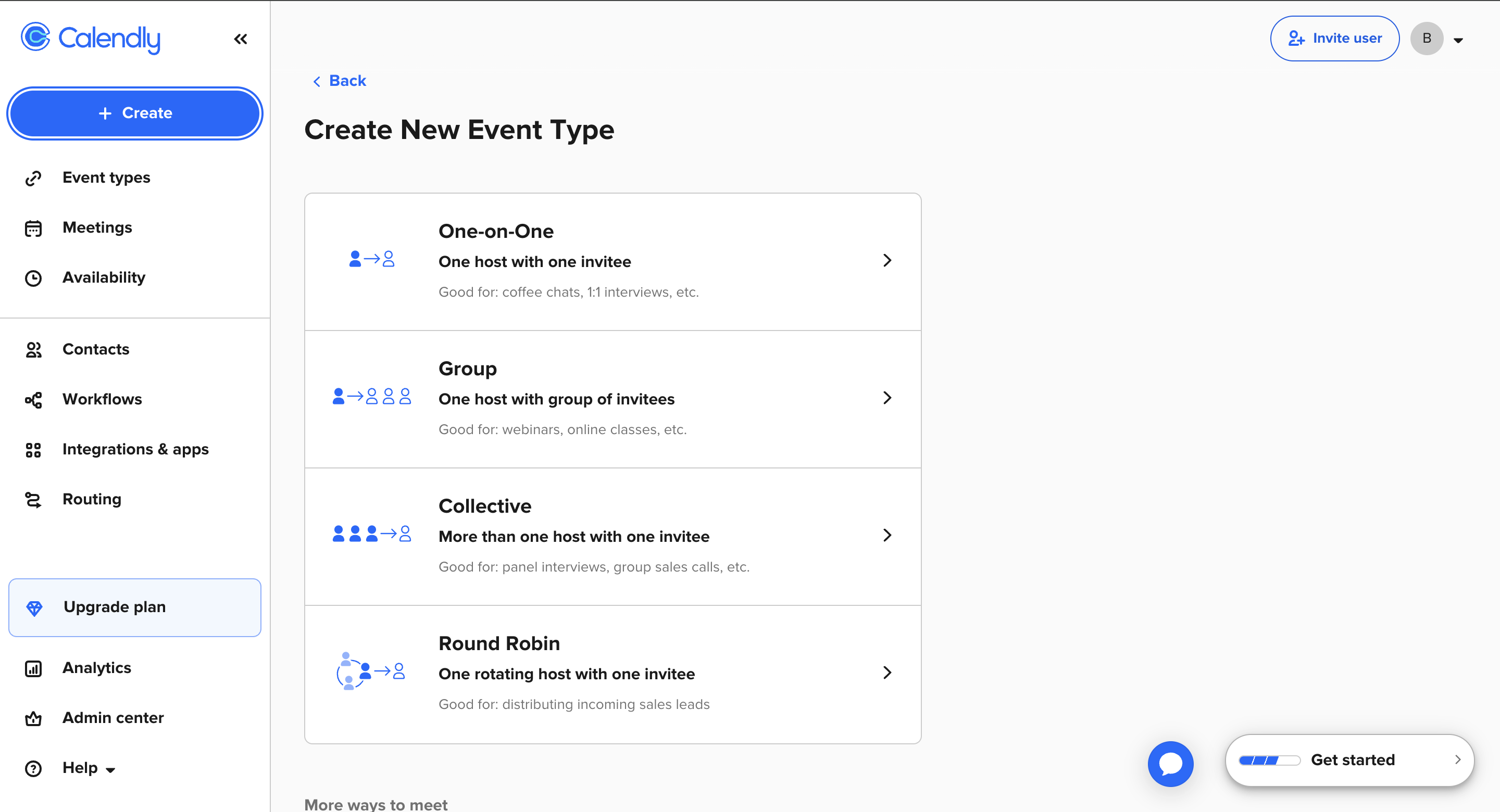
Both Calendly and Trafft offer robust scheduling options, but the choice between them may depend on specific needs such as ease of use, integration capabilities, and the complexity of scheduling requirements.
Integrations
If you want to streamline your workflow as much as possible, looking at the specific integrations each tool offers is essential. Both Trafft and Calendly provide various integrations to enhance their functionality and improve your scheduling experience.
For starters, they both offer integrations with many online calendars and video conferencing platforms, including Zoom and Google Meet. Additionally, they offer payment integrations with PayPal and Stripe. Trafft also offers Mollie and Authorize.Net, while Calendly offers Stax Payments.
Trafft’s marketing integrations include Zapier, Google Analytics, Mailchimp, SendFox, Acumbamail, webhooks, and much more. As for Calendly, it offers integrations with Mailchimp, ZoomInfo, Clearbit, Google Analytics, Marketo, and many other tools.
As this is subject to change as each tool develops even further, we recommend you visit Trafft’s and Callendly’s websites and see the extensive list of integrations they offer.
Pricing: Which one will cost you more?
While both tools offer a lifetime free version, if you are looking to add more employees or use it on a company level, the prices differ significantly. When making an executive decision on which to incorporate, Trafft or Callendly, understanding their pricing structures can help you determine which one fits your needs and budget.
Trafft’s pricing plans
- Free Plan - It allows you to add up to five team members, create your booking website, send email and SMS notifications, and offer unlimited appointments. You can also add one location, make coupons, offer group bookings, and connect calendars. On top of all of this, you can choose up to five custom features completely free of charge.
- Starter Plan - For $29, you get everything the same as the free plan plus an unlimited number of locations, the ability to send out branded invoices, and add up to ten custom features. Additionally, you can accept online payments from the clients.
- Scaling Plan - For $69, you can add 15 team members (compared to 10 with the Starter plan), add an unlimited number of custom features, remove Trafft branding, make your custom domain, and incorporate Whatsapp messaging.
- Enterprise - This is a plan for big companies as it allows over 50 users for a price of $250. You get everything offered in other plans plus a dedicated account manager, assistance with onboarding and education, as well as an individual server.
The prices mentioned are for those who choose to sign up for a monthly plan. But, if you choose an annual plan, it gets much more affordable. Check out Trafft’s pricing page to see the most relevant billing information.
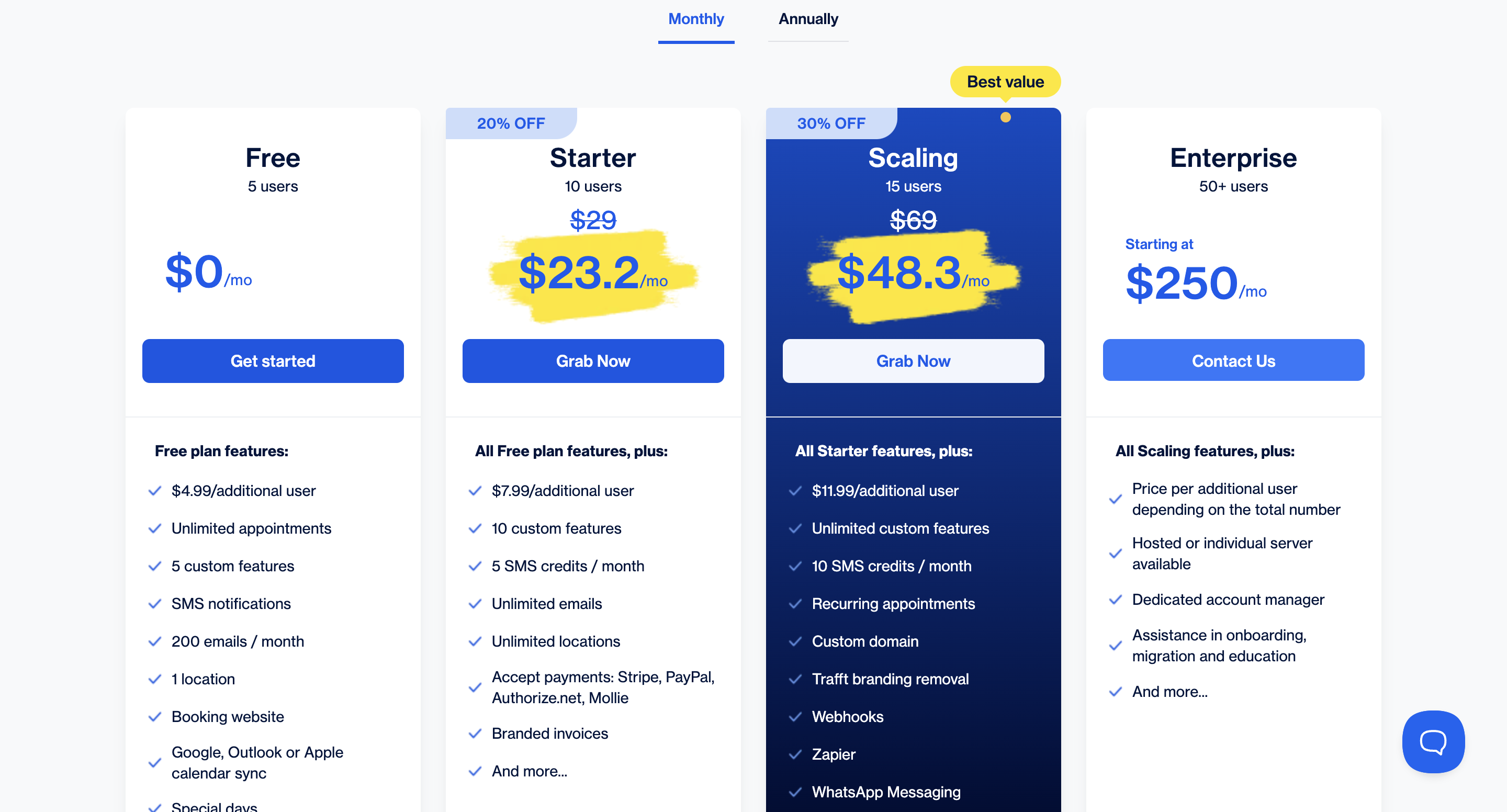
Calendly’s pricing plans
Similar to its peer, Calendly also offers four different pricing plans:
- Free Plan - Offers unlimited one-on-one meetings, just one event type, and connects to your calendar. Additionally, you can send email confirmations, integrate a video conferencing platform, and embed a scheduling form to your website.
- Standard Plan - For $12 a month, you can offer unlimited types of events, connect multiple calendars, use online payment platforms, automate reminders, customize your page, and have 24/7 chat support. However, you can have only one user and pay extra to add more.
- Teams - You have all the same features as a Standard plan but also more advanced admin features. Additionally, you’ll be able to use Hubspot, Marketo, and Salesforce. This plan costs $20 a month for a single user.
- Enterprise - This plan can only be billed yearly, starting at $15,000. In addition to everything already mentioned, it offers domain control, customer success representative, integration with Microsoft Dynamics, and SSO and SAML.
As mentioned, all the prices are for monthly plans. You can choose to sign up for an annual plan, which will help you save in the long run.
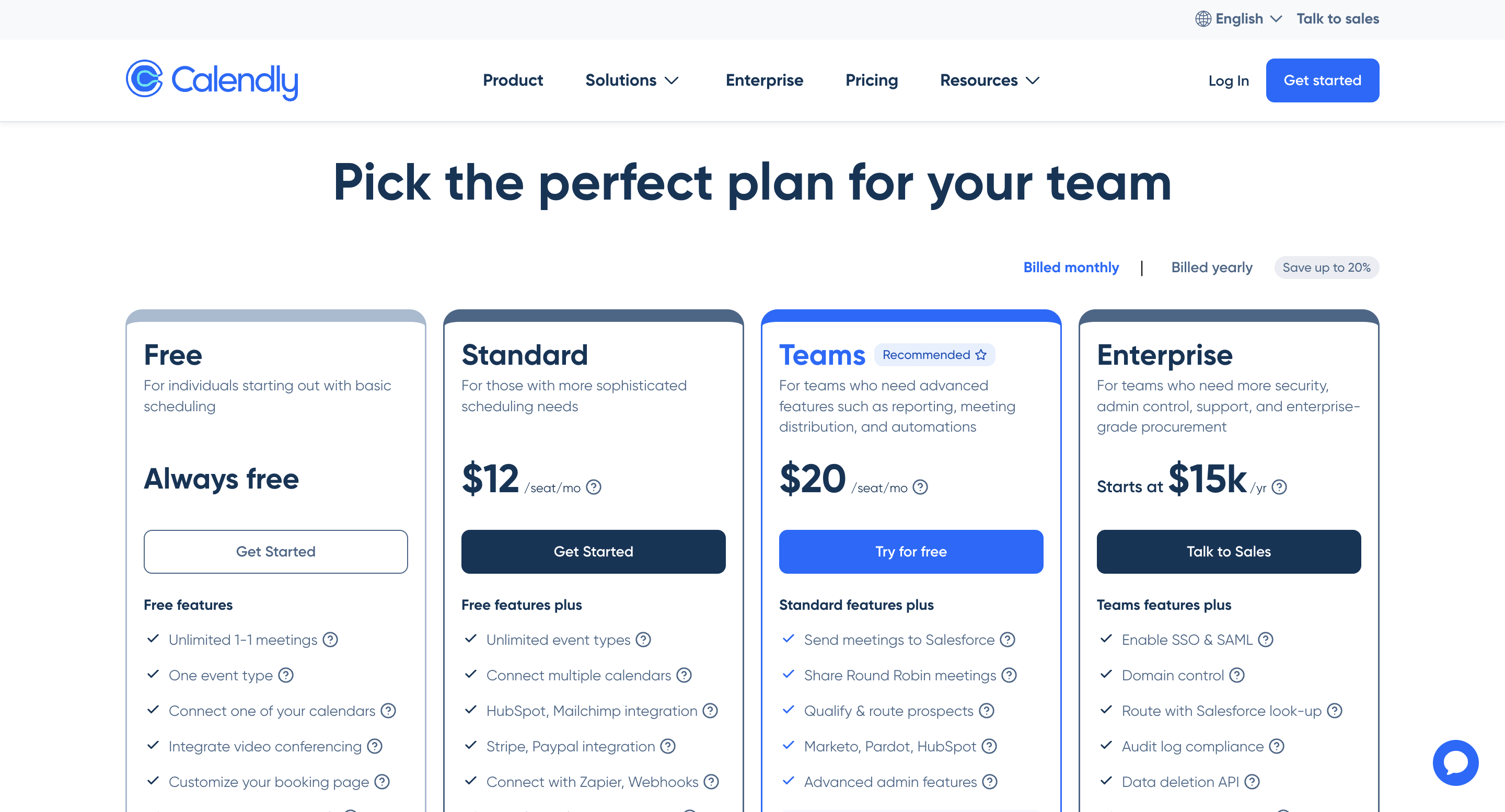
Pricing comparison
Now that we listed out all the plans offered, your question probably is - which one will cost you less but offer more?
While needs can differ depending on a specific industry you are in and business size, when we look at the math, Trafft offers a more comprehensive set of features at a lower price point.
If you plan to use a scheduling tool only for yourself, have no other team members, and just want simplicity, Calendly can be a great option. On the other hand, Trafft is completely free for up to five users, which many think is a much better deal.
Support: Who Offers Better Assistance?
Judging by reviews, both software offers impressive customer support, with high praises for support quality. The main difference is that Calendly offers 24/7 live chat support with its paid plans.
As for Trafft, customer support is provided through various channels, including email, phone, and chat. The support team will assist with any issues or questions related to the platform and its features. Additionally, many users compliment Trafft’s customer support for being very responsive and going the extra mile to assist the clients. Here is a review from one of the customers who actually switched from Calendly to Trafft:
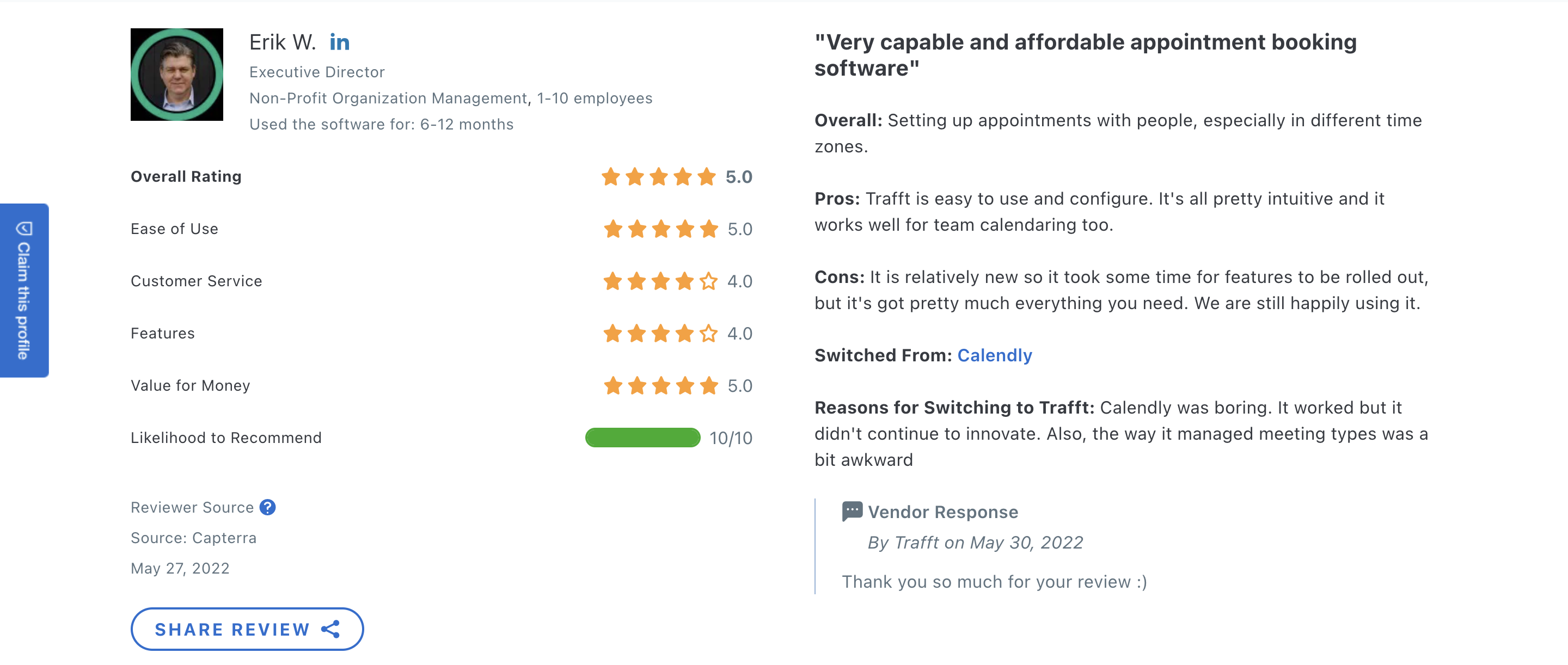
Moreover, both Calendly and Trafft have a section dedicated to frequently asked questions, which can help you with some of the common queries.
Overview of customer reviews
Before deciding to purchase anything, many people turn to customer reviews to see other people’s opinions and experiences. This is a great source of information if you want to gain insights into how well a tool meets the needs of real-world users. In this section, we'll delve into a variety of customer feedback to provide a comprehensive overview of how Trafft and Calendly perform.
Trafft vs. Calendly reviews
With a 4.9 star rating on Captera and GetApp, Trafft is clearly well-loved by users who appreciate its intuitive interface, advanced features, and impeccable customer support. And with equally good reviews on G2 and Trustpilot, it’s evident that this scheduling tool delivers consistent satisfaction across various review sites.
Judging by many reviews, if you are looking for a feature-rich tool for minimal costs, Trafft is definitely a way to go. Additionally, with so many people switching from Calendly, it’s obvious customization is just as important as ease of use.
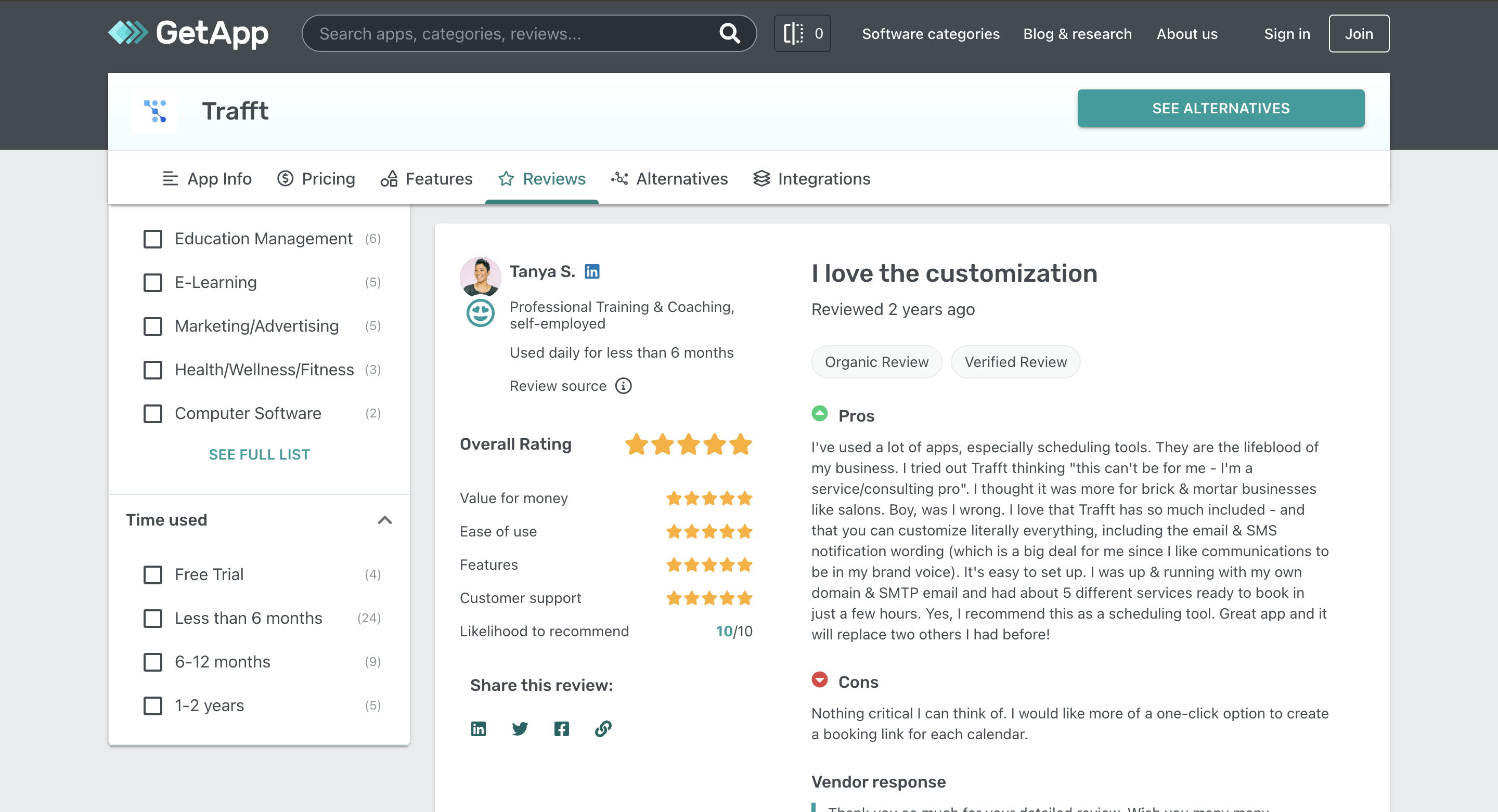
On the other hand, when we look at Calendly reviews, lower star ratings also come with mixed feedback across all review platforms.
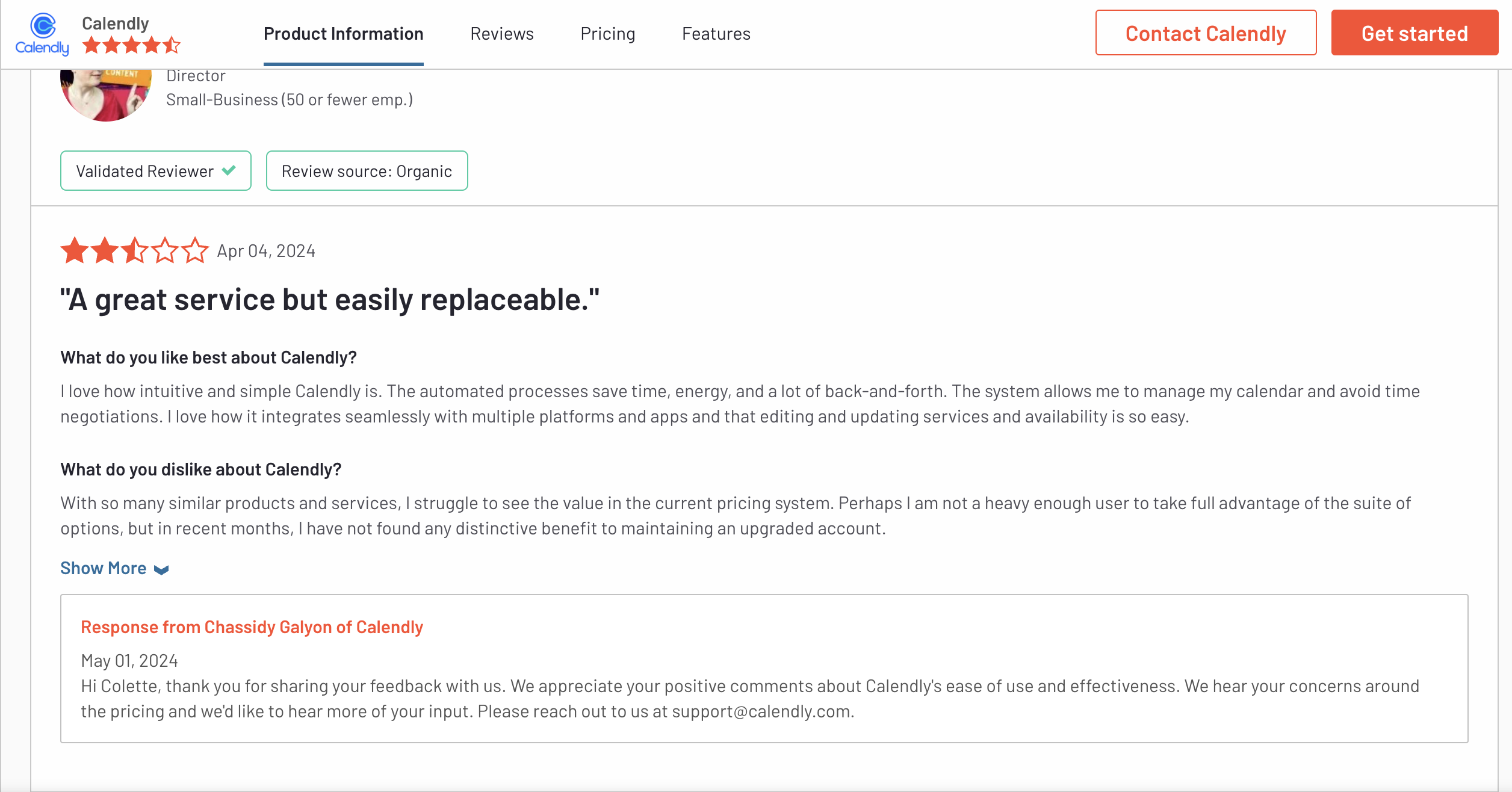
Besides its easy replaceability, many customers feel that Calendly is getting too expensive over time.
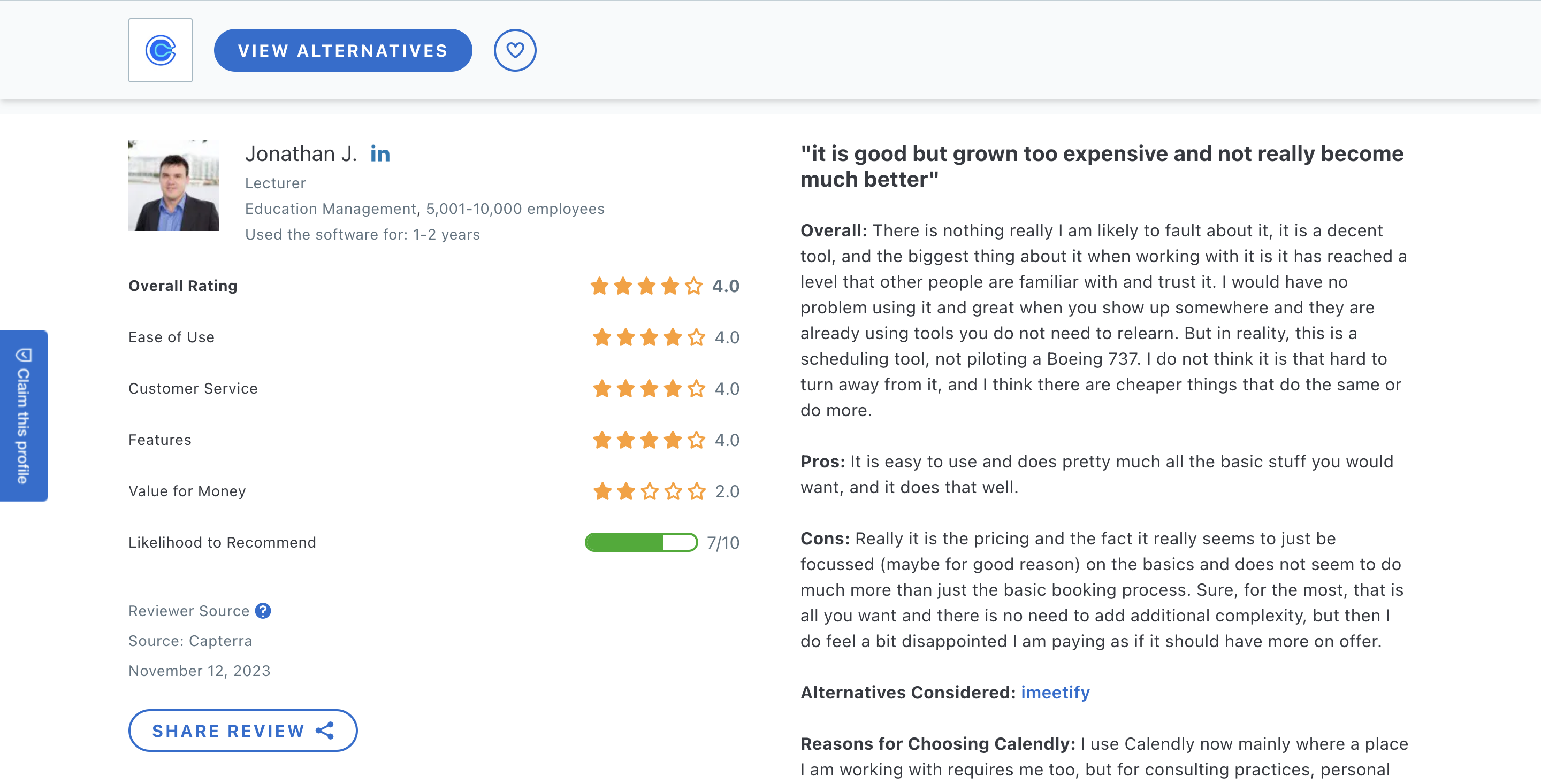
Lastly, many reviews highlight the lack of more advanced features and feel like, due to this, it wouldn’t be suitable for bigger businesses.
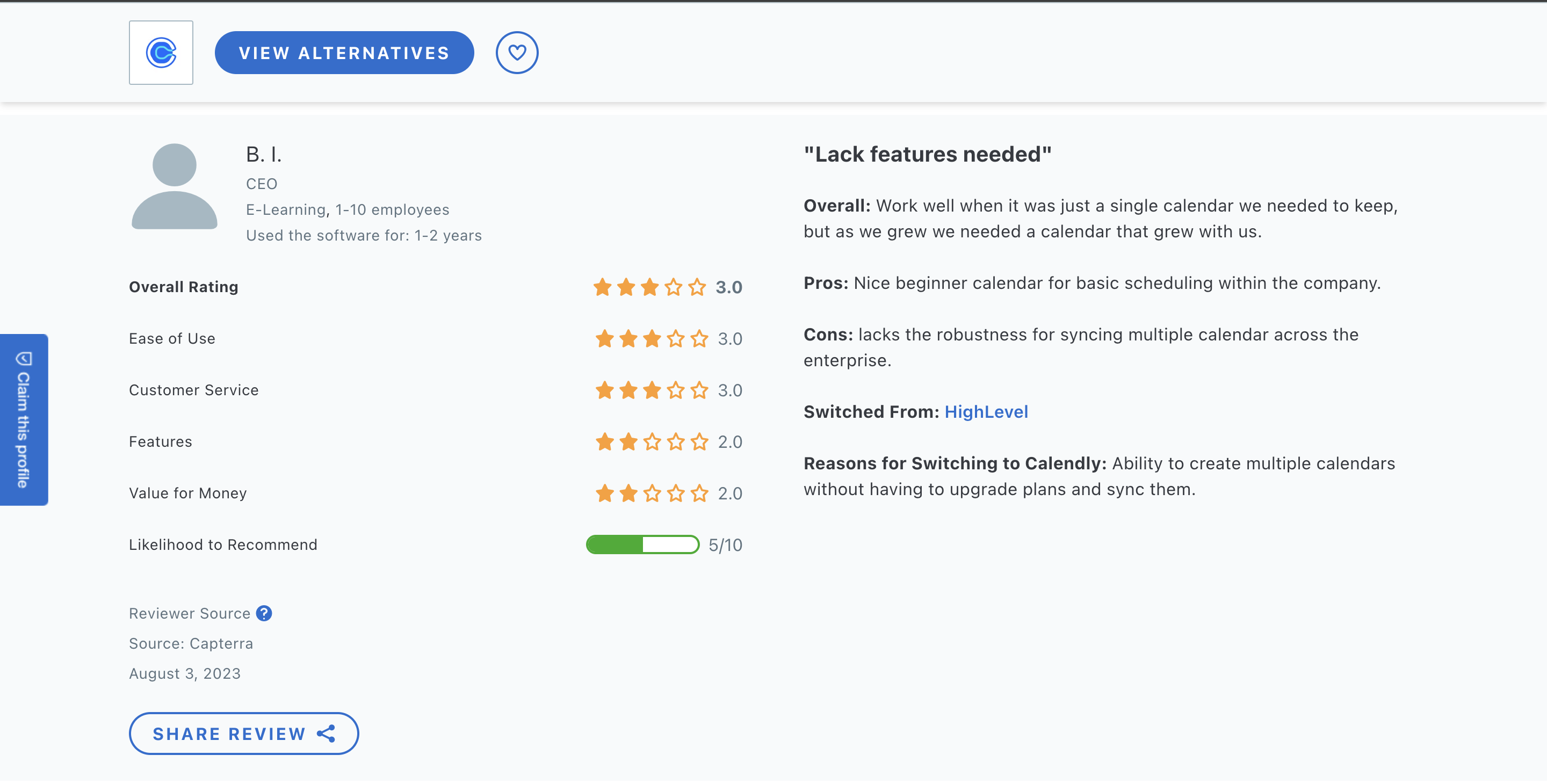
So, How Do They Compare?
While it’s obvious both tools have so many similar features, there still are some differences that could impact your decision.
When choosing between Trafft and Calendly, the final verdict largely depends on your specific needs and preferences. Calendly stands out for its straightforward, user-friendly interface, making it ideal for individuals and small teams seeking a simple meeting scheduling tool. It offers essential features like round-robin scheduling and seamless calendar integrations, with 24/7 live chat support available on paid plans.
In contrast, Trafft provides a more feature-rich experience with advanced options such as recurring appointments, multiple location management, and extensive customization. It supports a broader range of payment gateways and many marketing tools, making it a robust choice for businesses with more complex scheduling needs. Trafft's pricing is also far more affordable, especially when looking at the longer subscription plans.
Conclusion
In the end, the Trafft vs Calendly discussion boils down to your specific requirements and how you prioritize different features. Trafft stands out for its depth of customization and advanced features, making it ideal for businesses that require a flexible and robust scheduling system. Additionally, the ability to make it completely fit your brand is, for many, the most important factor.
For businesses that operate in multiple locations, want to streamline scheduling for a client, and easily accept payments online, Trafft is the perfect choice.
On the other hand, Calendly emphasizes simplicity, making it a strong contender for individuals who don’t care much about the design. Just keep in mind that you will be limited to only one type of event and won’t be able to send reminders automatically if you don’t upgrade to the paid version. In contrast, you’ll not encounter these limitations with Trafft’s free version.
Be sure to weigh out all the pros and cons before deciding. Moreover, explore Trafft today and see why so many service business owners can’t live without it.

